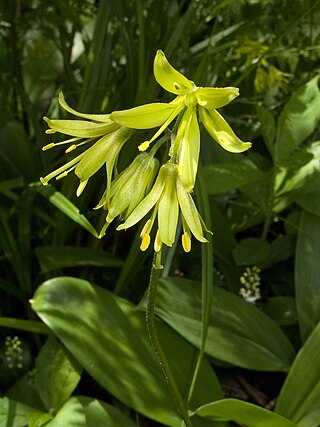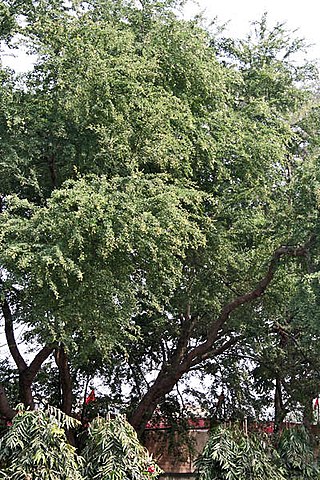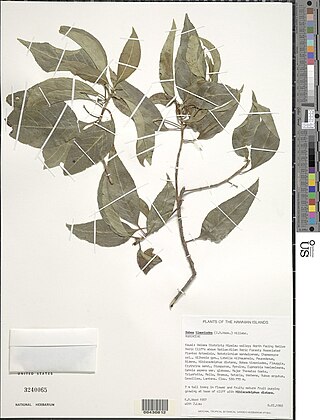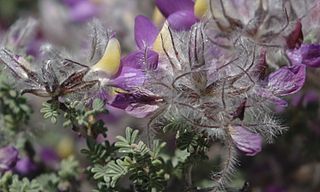
Quercus fusiformis, commonly known as escarpment live oak, plateau live oak, plateau oak, or Texas live oak, is an evergreen or nearly evergreen tree. Its native range includes the Quartz Mountains and Wichita Mountains in southwestern Oklahoma, through Texas, to the Mexican states of Coahuila, Tamaulipas, and Nuevo León.

Linnaea borealis is a species of flowering plant in the family Caprifoliaceae. It is the only species in the genus Linnaea. It is a boreal to subarctic woodland subshrub, commonly known as twinflower.

Clintonia borealis is a species of flowering plant in the lily family Liliaceae. The specific epithet borealis means "of the north," which alludes to the fact that the species tends to thrive in the boreal forests of eastern Canada and northeastern United States.

Vachellia farnesiana, also known as Acacia farnesiana, and previously Mimosa farnesiana, commonly known as sweet acacia, huisache, casha tree, or needle bush, is a species of shrub or small tree in the legume family, Fabaceae. Its flowers are used in the perfume industry.

Astragalus newberryi, is a flowering plant in the family Fabaceae, native to the western United States from Idaho to New Mexico and California. A variety is found in the Death Valley area and the eastern Mojave Desert in California and Nevada. It grows in rocky and gravelly areas between 1,300–2,350 metres (4,270–7,710 ft) elevation.

Calycanthus floridus, or commonly known as the eastern sweetshrub, Carolina all spice, or spicebush, is a species of flowering shrub in the family Calycanthaceae. It is identifiable by its dark red flowers and fragrant scent. It is non-invasive and is found in the Southeastern United States region. The Nature Conservancy considers its conservation status to be G5, globally secure, indicating it is at low risk of extinction. It is presumed to have been extirpated from Ohio.

Dicentra canadensis, the squirrel corn, is a flowering plant from eastern North America with oddly shaped white flowers and finely divided leaves.

Rubus deliciosus is a North American species of flowering plant in the rose family Rosaceae, native to the United States. Common names include the delicious raspberry, boulder raspberry, Rocky Mountain raspberry or snowy bramble.

Pithecellobium dulce, commonly known as Manila tamarind, Madras thorn, monkeypod tree or camachile, is a species of flowering plant in the pea family, Fabaceae, that is native to the Pacific Coast and adjacent highlands of Mexico, Central America, and northern South America. It is also sometimes known as monkeypod, but that name is also used for several other plants, including Samanea saman. It is an introduced species and extensively naturalized in the Caribbean and Florida, as well as the Philippines and Guam via the Manila galleons. It has also been introduced to Cambodia, Thailand and South Asia, It is considered an invasive species in Hawaii.

Texas A&M University–San Antonio is a public university in San Antonio, Texas. It is part of the Texas A&M University System. The university was established on May 23, 2009, and held its first classes as a stand-alone university on August 20, 2009. It currently enrolls more than 7,300 students and offers undergraduate and graduate-level classes, as well as a graduate alternative teacher certification program. Texas A&M–San Antonio has 161 full and part-time faculty. Texas A&M–San Antonio is the first Texas A&M University System institution to be established in a major urban center.

ʻAhakea is a species of flowering tree in the coffee family, Rubiaceae, that is endemic to Hawaiʻi. It inhabits dry, coastal mesic and mixed mesic forests at elevations of 250–580 metres (820–1,900 ft) on the islands of Hawaiʻi and Maui. It is threatened by habitat loss.

Texas A&M University School of Law is the law school of Texas A&M University located in downtown Fort Worth, Texas. Established in 1989 as the Texas Wesleyan University School of Law, it was formerly the law school of Texas Wesleyan University until it was acquired by Texas A&M University on August 12, 2013. On August 13, 2013, fully accredited by the American Bar Association, it began operations at the same location. The law school is a member of the Association of American Law Schools (AALS) and offers the Juris Doctor (J.D.) degree. Students may also pursue a Master of Laws (LL.M.) or Master of Legal Studies (M.L.S.) degree either online or in-residence.

Lithophragma parviflorum is a species of flowering plant in the saxifrage family known by the common name smallflower woodland star. It is native to much of western North America from British Columbia to California to South Dakota and Nebraska, where it grows in several types of open habitat. It is a rhizomatous perennial herb growing erect or leaning with a naked flowering stem. The leaves are mainly located low on the stem, each cut into three lobes or divided into three lobed leaflets. The stem bears up to 14 flowers, each in a cuplike calyx of red or green sepals. The five petals are bright white, up to 1.6 centimeters long, and usually divided into three toothlike lobes.

The Bush School of Government & Public Service is an academic college of Texas A&M University founded in 1997 under former President George H. W. Bush's philosophy that "public service is a noble calling." Since then, the Bush School has continued to reflect that notion in curriculum, research, and student experience and has become a leading international affairs, political science, and public affairs institution.
Parkinsonia texana is a species of perennial flowering tree in the pea family, Fabaceae, native to Texas and the Mexican states of Coahuila, Nuevo Leon, San Luis Potosi, and Tamaulipas. Common names include Texas palo verde, Border palo verde, and Retama china.

Mimosa microphylla, commonly called littleleaf sensitive-briar, eastern sensitive-briar, or little leaf mimosa, is a species of flowering plant in the legume family (Fabaceae). It is a perennial herb native to North America, where it is found primarily in the southeastern United States. Its typical natural habitat is in dry woodlands and forests, although it can also be found in disturbed areas.

Platanthera dilatata, known as tall white bog orchid, bog candle, or boreal bog orchid is a species of orchid, a flowering plant in the family Orchidaceae, native to North America. It was first formally described in 1813 by Frederick Traugott Pursh as Orchis dilatata.

I.D. Fairchild State Forest is a 2,760-acre (1,120 ha) nature preserve in Cherokee County, Texas. It is the largest state forest in Texas and includes 10 miles of hiking trails. The main unit is located just west of the community of Maydelle on Texas State Highway 84. It is open to the public for hiking, horseback riding, picnicking, wildlife viewing, and biking. The Texas A&M Forest Service uses the area for demonstration and research as well as to conserve southern yellow pine ecosystems. The Texas State Railroad also runs through the forest.
Monarda russeliana is a species of flowering plant in the mint family. It is commonly known as redpurple beebalm and Russell's beebalm.

Dalea formosa is a species of flowering plant in the genus Dalea, known by the common names feather dalea and featherplume; it is named for the physician Samuel Dale. The plant is native to the southern United States. It is highly tolerant of heat, cold, and drought. It is favored by honeybees; but of much less use to most wildlife, with the exception of rabbits and deer. Unique to most plants, it blooms all year long and also has a long lifespan.



















